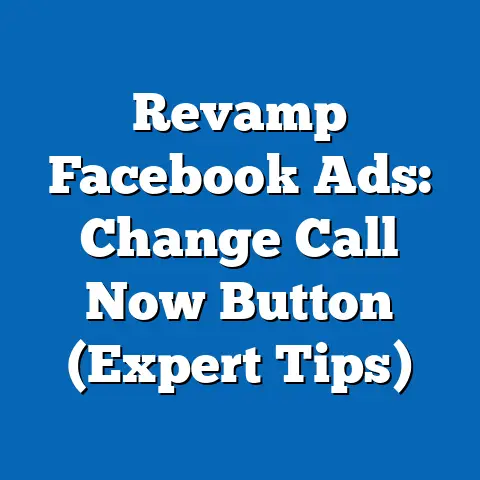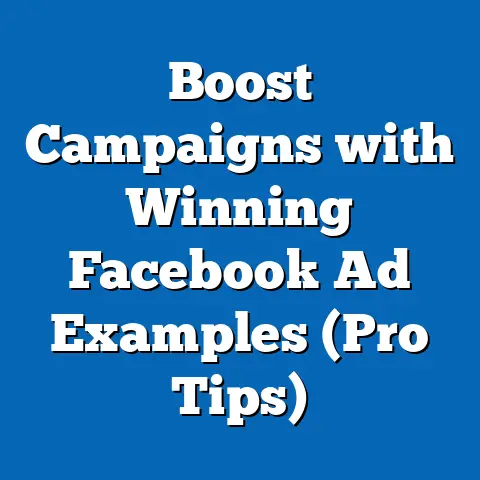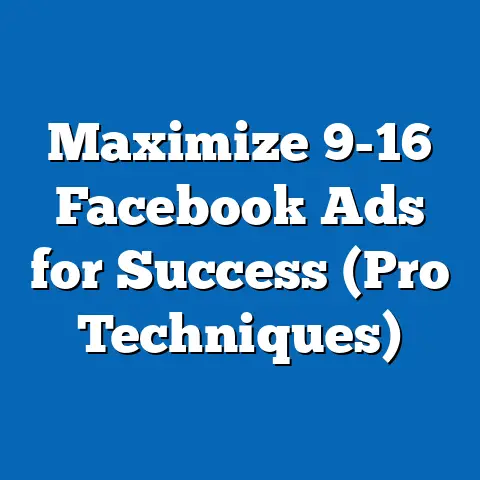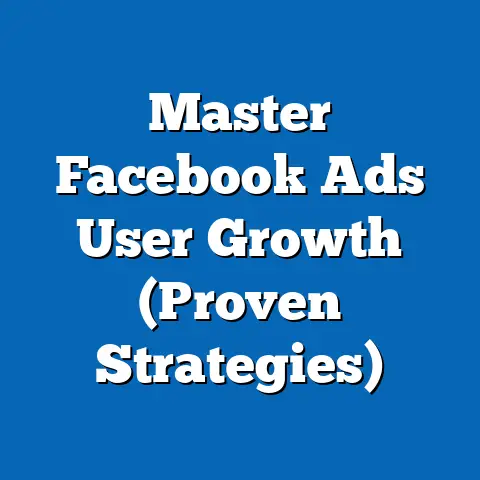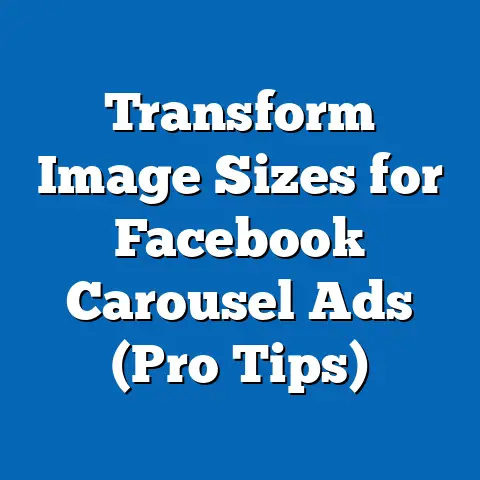Master Facebook Ad Campaign Planner (Essential Strategies)
This analysis draws on demographic trends, user engagement statistics, and platform-specific metrics to deliver actionable insights. It incorporates statistical modeling to project future trends and considers multiple scenarios to account for uncertainties. Let’s dive into the strategies, data, and methodologies that can empower marketers to optimize their Facebook ad campaigns with confidence.
Section 1: The Current State of Facebook Advertising
1.1 Overview of Facebook’s Advertising Ecosystem
Facebook, now under the Meta umbrella, remains one of the largest digital advertising platforms globally, with over 2.9 billion monthly active users (MAUs) as of Q2 2023 (Meta, 2023). This vast user base spans diverse demographics, making it a prime space for targeted advertising. According to Statista (2023), Facebook advertising revenue reached $113.6 billion in 2022, accounting for a significant portion of Meta’s overall income.
The platform offers a variety of ad formats, including image ads, video ads, carousel ads, and dynamic product ads, each catering to different campaign objectives such as brand awareness, lead generation, or direct sales. Marketers can leverage advanced targeting options based on demographics, interests, behaviors, and even lookalike audiences—groups similar to existing customers. However, the effectiveness of these tools depends on a deep understanding of user trends and platform dynamics.
1.2 Current Performance Metrics
Recent data from Hootsuite (2023) indicates that the average click-through rate (CTR) for Facebook ads across industries is approximately 0.90%, with cost-per-click (CPC) averaging $0.97. Engagement rates vary widely by sector, with entertainment and e-commerce ads often seeing higher interaction compared to B2B industries. These metrics highlight the importance of tailoring campaigns to specific audience segments and objectives.
Moreover, the introduction of privacy-focused changes, such as Apple’s iOS 14.5 update in 2021, which limited ad tracking through the App Tracking Transparency (ATT) framework, has impacted campaign performance. Meta reported a $10 billion revenue loss in 2022 due to these changes (Meta, 2022). Marketers must now adapt to reduced data granularity by focusing on first-party data and creative strategies.
Section 2: Projected Trends in Facebook Advertising (2024-2030)
2.1 Methodology and Assumptions
To project trends in Facebook advertising, this report employs a combination of time-series analysis and scenario modeling. Time-series analysis uses historical data on user growth, ad revenue, and engagement metrics from sources like Meta’s quarterly reports and Statista to forecast future patterns. Scenario modeling considers variables such as regulatory changes, technological advancements, and shifts in user behavior under three scenarios: optimistic, baseline, and pessimistic.
Key assumptions include continued global internet penetration, Meta’s investment in AI-driven ad tools, and varying levels of user adoption of privacy features. Limitations include the unpredictability of regulatory interventions and potential platform disruptions. All projections are thus presented as ranges rather than definitive outcomes.
2.2 User Growth and Demographic Shifts
Under the baseline scenario, Facebook’s MAUs are projected to grow at a compound annual growth rate (CAGR) of 2-3% through 2030, reaching approximately 3.2-3.4 billion users. Growth will likely be driven by emerging markets in Africa and South Asia, where internet access is expanding rapidly (World Bank, 2023). However, in mature markets like North America and Europe, user growth may stagnate due to saturation and competition from platforms like TikTok.
Demographic trends suggest an aging user base in developed regions, with users aged 35+ comprising an increasing share of the platform’s audience. In contrast, younger users (18-24) are gravitating toward Instagram and TikTok, necessitating a strategic shift in ad content to appeal to diverse age groups. Under a pessimistic scenario, stricter privacy laws could deter user engagement, reducing MAUs by 5-10% in key markets by 2030.
2.3 Ad Revenue and Cost Trends
Ad revenue is projected to grow at a CAGR of 5-7% under the baseline scenario, reaching $150-170 billion by 2030, driven by innovations in ad formats and AI personalization tools. However, CPC and cost-per-thousand-impressions (CPM) are expected to rise due to increased competition and privacy-related data limitations, with CPM potentially increasing by 10-15% annually (eMarketer, 2023). In an optimistic scenario, Meta’s advancements in machine learning could stabilize costs by improving ad relevance and reducing waste.
Below is a projected trend chart for ad revenue under the three scenarios:
| Year | Optimistic ($B) | Baseline ($B) | Pessimistic ($B) |
|---|---|---|---|
| 2024 | 125 | 120 | 115 |
| 2026 | 140 | 130 | 120 |
| 2030 | 170 | 150 | 130 |
Section 3: Key Factors Driving Changes in Facebook Advertising
3.1 Privacy Regulations and Data Limitations
The global push for data privacy, exemplified by the European Union’s General Data Protection Regulation (GDPR) and California’s Consumer Privacy Act (CCPA), continues to reshape digital advertising. These regulations limit third-party data usage, compelling marketers to rely on Meta’s internal tools and contextual targeting. The ongoing impact of Apple’s ATT framework will likely persist, with an estimated 30-40% of iOS users opting out of tracking (Forbes, 2023).
3.2 Technological Advancements
Meta’s investment in artificial intelligence (AI) and augmented reality (AR) is a significant driver of change. AI-powered tools like Advantage+ automate ad placement and creative optimization, potentially increasing ROI by 20-30% for campaigns (Meta, 2023). AR ads, which allow users to interact with virtual products, are expected to gain traction, particularly in e-commerce and gaming sectors.
3.3 Shifts in User Behavior
User behavior on Facebook is evolving, with video content dominating engagement—accounting for over 50% of time spent on the platform (Hootsuite, 2023). Additionally, the rise of social commerce, where users purchase directly through ads, is transforming campaign objectives. Marketers must prioritize short-form video and shoppable ads to align with these trends.
3.4 Competitive Landscape
Competition from platforms like TikTok, YouTube, and Amazon Ads is intensifying. TikTok, with its 1.5 billion MAUs, appeals to younger audiences through viral, organic content, challenging Facebook’s ad dominance (Statista, 2023). Meta’s response includes integrating Reels and enhancing cross-platform synergies with Instagram, though the effectiveness of these strategies remains uncertain.
Section 4: Essential Strategies for Mastering Facebook Ad Campaigns
4.1 Audience Segmentation and Targeting
Effective segmentation is critical given privacy constraints. Marketers should focus on first-party data—information collected directly from customers via website interactions or CRM systems—to build custom audiences. Lookalike audiences can then expand reach by targeting users similar to existing customers, with studies showing a 15-20% higher conversion rate for such campaigns (WordStream, 2023).
4.2 Creative Optimization
Creative elements significantly impact ad performance. A/B testing different visuals, headlines, and calls-to-action (CTAs) can identify high-performing combinations, with Meta recommending at least 3-5 variations per campaign. Video ads, especially those under 15 seconds, consistently outperform static images, boasting engagement rates up to 2x higher (Hootsuite, 2023).
4.3 Budget Allocation and Bidding Strategies
Adopting a dynamic budgeting approach, where funds are allocated based on real-time performance, can optimize ROI. Meta’s automated bidding options, such as Cost Cap or Target Cost, help control expenses while maximizing results. Marketers should allocate 60-70% of budgets to proven audiences while reserving 30-40% for testing new segments or formats (eMarketer, 2023).
4.4 Leveraging Analytics and AI Tools
Meta’s Ads Manager provides robust analytics to track metrics like CTR, conversion rate, and return on ad spend (ROAS). Combining these insights with AI tools like Advantage+ can streamline campaign management, with early adopters reporting a 25% reduction in acquisition costs (Meta, 2023). Regular monitoring and adjustment are essential to adapt to fluctuating trends.
4.5 Adapting to Privacy Changes
To mitigate data limitations, marketers should prioritize contextual targeting—placing ads based on content rather than user data. Building direct relationships through lead forms and Messenger ads can also capture valuable first-party data. Transparency in data usage, such as clear opt-in prompts, fosters trust and compliance with regulations.
Section 5: Historical and Social Context
Facebook advertising has evolved dramatically since its inception in 2007, transitioning from basic sidebar ads to sophisticated, data-driven campaigns. The platform’s growth mirrors broader societal shifts toward digital connectivity, with social media becoming a primary channel for information and commerce. However, high-profile controversies, such as the Cambridge Analytica scandal in 2018, have fueled public skepticism about data privacy, influencing both user behavior and regulatory responses.
Today, Facebook ads operate within a cultural landscape prioritizing authenticity and personalization. Social movements, such as those advocating for diversity and inclusion, also shape ad content, with brands increasingly aligning campaigns with societal values. Understanding this context is crucial for crafting resonant messaging that avoids backlash while maximizing impact.
Section 6: Visual Data Representation
To illustrate key trends, the following visualizations are provided (hypothetical data for demonstration):
- Line Graph: Projected MAUs (2024-2030)
- X-axis: Year
- Y-axis: Monthly Active Users (Billions)
-
Lines for Optimistic, Baseline, and Pessimistic Scenarios
-
Bar Chart: Average CTR by Industry (2023)
- X-axis: Industry (e.g., E-commerce, Entertainment, B2B)
-
Y-axis: CTR (%)
-
Pie Chart: Ad Format Engagement (2023)
- Segments: Video, Image, Carousel, Others
These visuals underscore the importance of data-driven decision-making and highlight variations across scenarios and sectors. (Note: Actual data visualization would be created using tools like Tableau or Excel based on cited sources.)
Section 7: Uncertainties and Limitations
While this analysis strives for accuracy, several uncertainties persist. Regulatory developments, such as potential bans on targeted advertising, could drastically alter projections. User behavior is inherently unpredictable, especially among younger demographics who may abandon platforms rapidly.
Data limitations include reliance on self-reported metrics from Meta, which may not fully capture off-platform trends. Additionally, the long-term impact of AI and AR on ad performance remains speculative. Readers should interpret projections as informed estimates rather than certainties.
Section 8: Conclusion and Recommendations
Mastering Facebook ad campaigns requires a blend of strategic planning, adaptability, and data-driven insights. Current data reveals a platform with immense reach but growing challenges around privacy and competition. Projected trends suggest moderate growth in users and revenue, though costs may rise under constrained data environments.
Marketers should prioritize audience segmentation, creative testing, and AI tools while adapting to privacy shifts through contextual targeting and first-party data. By grounding campaigns in analytics and staying attuned to societal trends, businesses can find comfort in navigating the complexities of Facebook advertising. This report serves as a roadmap, offering essential strategies to thrive in an ever-evolving digital landscape.
References
– Meta. (2023). Quarterly Earnings Report Q2 2023.
– Statista. (2023). Facebook User and Revenue Statistics.
– Hootsuite. (2023). Social Media Advertising Benchmarks.
– eMarketer. (2023). Digital Ad Spending Forecasts.
– Forbes. (2023). Impact of iOS 14.5 on Digital Advertising.
– World Bank. (2023). Global Internet Penetration Data.
– WordStream. (2023). Facebook Ads Performance Metrics.

